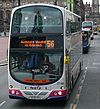
East Dunbartonshire is one of the 32 council areas of Scotland. It borders Glasgow City Council Area to the south, North Lanarkshire to the east, Stirling to the north, and West Dunbartonshire to the west. East Dunbartonshire contains many of the suburbs in the north of Greater Glasgow, including Bearsden, Milngavie, Bishopbriggs, Kirkintilloch, Lenzie, Twechar, Milton of Campsie, Balmore, and Torrance, as well as some other of Glasgow's commuter towns and villages. The council area covers parts of the historic counties of Dunbartonshire, Lanarkshire, and Stirlingshire.
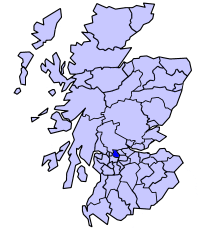
Strathkelvin is the strath (valley) of the River Kelvin in west central Scotland, lying north-east of Glasgow. The name Strathkelvin was used between 1975 and 1996 for one of nineteen local government districts in the Strathclyde region.

Baldernock meaning 'settlement of St Earnaig' is a small parish in East Dunbartonshire, Scotland, ten miles (16 km) to the north of Glasgow's city centre.

Lenzie railway station is a railway station serving Lenzie and Kirkintilloch in East Dunbartonshire, Scotland. It is located on the Croy Line, 6+1⁄4 miles (10.1 km) northeast of Glasgow Queen Street. Trains on the Glasgow to Edinburgh via Falkirk Line pass Lenzie by. The station is served by ScotRail.
The Glasgow to Aberfoyle Line was a railway line in Scotland, built in stages, leaving the Edinburgh and Glasgow Railway near Lenzie. Tourist traffic was a dominant part of the motivation for building the line, and road tours to the Trossachs from Aberfoyle formed a significant part of the traffic.
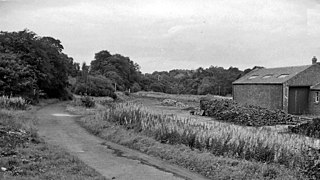
Balerno railway station was opened in 1874 and served the area of the village of Balerno that now forms part of the city of Edinburgh. Although primarily built as a goods line, with a dedicated goods station at Balerno, serving the many mills on the Water of Leith, a passenger service was provided by the Caledonian Railway using the Balerno Loop and after grouping by the London, Midland and Scottish Railway, seeing formal closure to passenger traffic shortly after nationalisation. The station was the only one with a separately served goods station on the 'loop' line and lay in rural surroundings that had been popular with families having a day out in the country.
The Kelvin Valley Railway was an independent railway designed to connect Kilsyth, an important mining town in central Scotland, with the railway network. It connected Kilsyth to Kirkintilloch and thence over other railways to the ironworks of Coatbridge, and to Maryhill, connecting onwards to the Queen's Dock at Stobcross.
Bridgefoot Halt railway station was opened in 1914. The halt was in the settlement of Bridgefoot close to the town of Banff. The line from Tillynaught opened in 1859 and a temporary terminus opened at Banff on 30 July 1859 and a permanent station opened in 1860. Bridgehouse Halt had a single platform and was opened by the GNoSR. The OS map of 1902 shows a 'Halt' at the site of the 1914 platform without indicating any structure at the site.

Golf Club House Halt railway station, also known as Banff Golf House Halt railway station was opened in 1914. The halt was located close to the town of Banff's golf club on the links. The line from Tillynaught opened in 1859 and a temporary terminus opened at Banff on 30 July 1859 and a permanent station opened in 1860. There was a single platform at the Golf Club House Halt, located on the shore side of the line and no provision for goods traffic. The OS map of 1902 shows a 'Halt' at the site of the 1914 platform without indicating any structure at the site.

Longridge railway station was the original terminus of the Wilsontown, Morningside and Coltness Railway (WM&CR) that served the nearby village of Longridge in West Lothian and it was also referred to as Eastern station and was 8 miles 50 chains (13.9 km) from Morningside station.
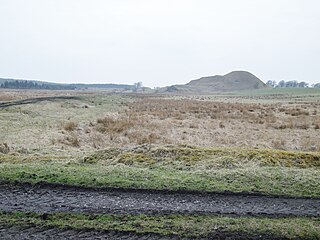
Headless Cross railway station or Headlesscross railway station was a station on the Wilsontown, Morningside and Coltness Railway (WM&CR) that served the rural area of Headless Cross near Fauldhouse in West Lothian. The station was located 4 miles 60 chains east of Morningside railway station.

Girvan Old railway station was a terminus station opened in Girvan, in Carrick, South Ayrshire, Scotland by the Maybole and Girvan Railway. Although ambitions existed to extend the line through to Stranraer it was built on a site that would not permit this and so when the line was built the Girvan New station was opened on 5 October 1877 by the Girvan and Portpatrick Junction Railway on the route to Pinmore and eventually through to Stranraer railway station.

Cleland (Old) railway station was opened in 1867 on the Cleland to Morningside Junction line that had opened in 1864. The extension of the Cleland Branch on the line of the old Wishaw and Coltness Railway joined the Coltness Branch section of the Wishaw and Coltness Railway via the Coltness Ironworks and then as stated it continued to Morningside.

Ravelrig Junction Platform railway station or Ravelrig Halt was originally opened in 1884 as a two platform station on the Shotts line on the edge of the Dalmahoy Estate in an area that now forms part of the city of Edinburgh. It stood just to the west of Ravelrig Junction that served the Balerno Loop Line. After closure in 1920 Ravelrig Platform for Dalmahoy Golf Course was opened at the same site around 1927 as a single platform when the Dalmahoy Estate became a hotel with a golf course, however it is stated to have closed in 1930. The site may have also served a military purpose.

Balmore railway station was opened in 1879 on the Kelvin Valley Railway and served the coal mining area, farms and the village of Balmore in East Dunbartonshire until 1951 for passengers and to freight on 31/7/61.
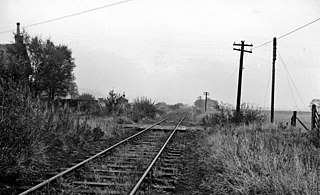
Bardowie railway station was opened in 1905 on the Kelvin Valley Railway, later than most of the other stations which had opened with the line itself in 1879. It served the hamlet of Bardowie and the coal mining area, farms, etc. in East Dunbartonshire until 1931 for passengers and to freight on 31 July 1961.
Twechar railway station was opened in 1878 as Gavell on the Kelvin Valley Railway and renamed Twechar in 1924. The station served the hamlet of Twechar and the coal mining area, Gavell House and Farm, etc. in East Dunbartonshire until 1951 for passenger travel. and to coal traffic to the Cadder Yard until 1966.

Broomhouse railway station was opened in 1878 at Broomhouse in the Baillieston area of Glasgow, Scotland on the old Glasgow, Bothwell, Hamilton and Coatbridge Railway between Shettleston and Hamilton. The miner's rows at Boghall were close to the station site.
Maryville railway station (NS687620) was opened in 1878 at Maryville, a small community in the Uddingston area to the south-east of Glasgow, Scotland on the old Glasgow, Bothwell, Hamilton and Coatbridge Railway between Shettleston and Hamilton. Clydeside and Bredisholm collieries were also served by the station.

Wilsontown railway station was the passenger terminus of the three and three quarter mile long Wilsontown Branch that ran from a bay platform at Auchengray railway station and served the nearby village of Wilsontown in Lanarkshire and several collieries. The only other station on the line was at Haywood, standing two miles from Auchengray on a double track section of the line. Apart from the collieries this was a mainly farming district at the times of the railway's construction.

















